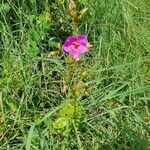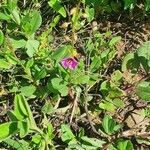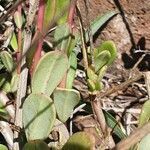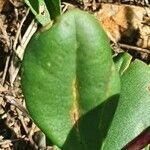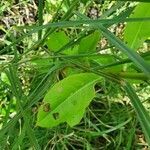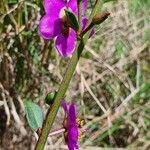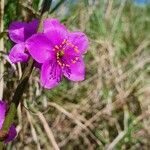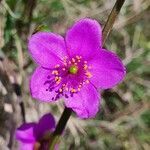A stout herb. It keeps growing from year to year. It can be softly woody. The stems are grey and sprawling. The root is thickened. The flowering stems are succulent. It grows 1 m high or 2 m long if lying over. The leaves are slightly fleshy. They are broadly oval and 2-8 cm long by 1-3 cm wide. The flowers are in groups at the top of the plant. They are along a 30 cm logn stalk. Flowers have both sexes. The fruit is a round capsule. It has 3 valves.
Inflorescence a terminal, elongated, racemose panicle or raceme; lower bracts leaf-like but diminishing in size upwards; peduncles c. 1·5 cm. long with 1–3 (6) flowers per peduncle; pedicels 0·7–1·5 cm. long, recurved in fruit; bracteoles 1–4 mm. long, membranous, ovate-lanceolate, apex acuminate.
Shrub with annual branches up to 1 m high. Leaves obovate, obtuse or rounded at apex. Inflorescence terminal, paniculate. Flowers pink or mauve.
Leaves subfleshy, almost sessile, 2–9 (14·5) × 1–3 (5·5) cm., obovate to oblanceolate, apex rounded or obtuse, mucronate, cuneate at the base.
Seeds 30–40, c. 1·2 mm. in diam., black, shining, subreniform, obscurely patterned with concentric rings of oblong cells.
Perennial glabrous herb with annual branches c. 1 m. tall from a thickened rootstock.
Petals purplish, rose-pink or almost white, 9–12 × 5–6 mm., obovate.
Ovary ovoid; style c. 1·5 mm. long; stigmas 3, spreading.
Capsule 5–7 mm. in diam., globose, shining yellow-green.
Stamens c. 25, with yellow filaments 3–4 mm. long.
Stout perennial herb, woody below, to 3 ft. high
Sepals 4–6 mm. long, ovate, apex apiculate.
Rare in our area.
Flowers pink

